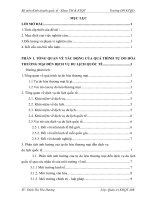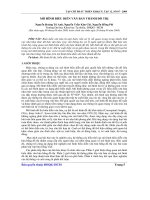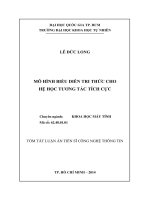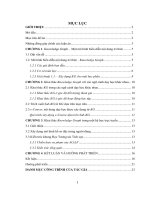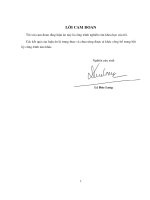Chuẩn dữ liệu GIS - P1
Bạn đang xem bản rút gọn của tài liệu. Xem và tải ngay bản đầy đủ của tài liệu tại đây (727.75 KB, 41 trang )
FGDC Document Number 1
2
3
4
5
Address Data Content Standard
6
Public Review Draft
7
8
9
10
Subcommittee on Cultural and Demographic Data
11
Federal Geographic Data Committee
12
13
April 17, 2003
14
Version 2 15
16
17
18
19
20
21
22
23
24
25
26
27
28
29
30
31
32
Federal Geographic Data Committee
33
Department of Agriculture, Department of Commerce, Department of Defense, Department of Energy
34
Department of Hou sing and Urban Development, Department of the Interior, Department of State
35
Department of Transportation, Environmental Protection Agency
36
Federal Emergency Management Agency, Library of Congress
37
National Aeronautics and Space Administration, National Archives and Records Administration
38
Tennessee Valley Authority
39
ii
Federal Geographic Data Committee 40
41
42
Established by Office of Management and Budget Circular A-16, the Federal Geographic Data Committee 43
(FGDC) promotes the coordinated development, use, sharing, and dissemination of geographic data. 44
45
The FGDC is composed of representatives from the Departments of Agriculture, Commerce, Defense, Energy, 46
Housing and Urban Development, the Interior, State, and Transportation; the Environmental Protection Agency; 47
the Federal Emergency Management Agency; the Library of Congress; the National Aeronautics and Space 48
Administration; the National Archives and Records Administration; and the Tennessee Valley Authority. 49
Additional Federal agencies participate on FGDC subcommittees and working groups. The Department of the 50
Interior chairs the committee. 51
52
FGDC subcommittees work on issues related to data categories coordinated under the circular. Subcommittees 53
establish and implement standards for data content, quality, and transfer; encourage the exchange of information 54
and the transfer of data; and organize the collection of geographic data to reduce duplication of effort. Working 55
groups are established for issues that transcend data categories. 56
57
For more information about the committee, or to be added to the committee’s newsletter mailing list, please 58
contact: 59
60
Federal Geographic Data Committee 61
c/o U.S. Geological Survey 62
590 National Center 63
Reston, Virginia 22092 64
65
Telephone: (703) 648-5514 66
Facsimile: (703) 648-5755 67
Internet (electronic mail):
68
World Wide Web: 69
Federal Geographic Data Committee FGDC Document Number
Address Data Content Standard-Public Review Draft April 17, 2003
iii
CONTENTS 70
71
Page 72
1.0 Introduction ............................................................................................................................................ 1 73
1.1 Objective ......................................................................................................................................... 1 74
1.2 Scope.............................................................................................................................................. 1 75
1.3 Applicability ................................................................................................................................... 276
1.4 Related Standards............................................................................................................................ 2 77
1.4.1 International Standards ........................................................................................................ 2 78
1.4.2 National Standards (United Kingdom).................................................................................. 3 79
1.4.3 FGDC Standards.................................................................................................................. 3 80
1.4.4 Agency Standards (United States) ........................................................................................4 81
1.4.4.1 USPS ...................................................................................................................... 4 82
1.4.4.2 Other U.S. Agency Standards .................................................................................. 5 83
1.4.5 Agency Standards (Canada) ................................................................................................. 6 84
1.5 Standards Development Process ......................................................................................................6 85
1.6 Maintenance Authority.................................................................................................................... 7 86
2.0 Definitions and Abbreviations.................................................................................................................. 7 87
2.1 Definitions ...................................................................................................................................... 7 88
2.2 Abbreviations.................................................................................................................................. 9 89
3.0 Requirements for an Address Specification ............................................................................................ 10 90
3.1 Address Purpose............................................................................................................................ 10 91
3.2 Address Type ................................................................................................................................ 10 92
3.2.1 Address Structures............................................................................................................. 12 93
3.3 Descriptive Elements..................................................................................................................... 12 94
4.0 References............................................................................................................................................. 14 95
96
Federal Geographic Data Committee FGDC Document Number
Address Data Content Standard-Public Review Draft April 17, 2003
iv
Tables Page 96
Table 1 Address Types ........................................................................................................................... 11 97
Table 2 Obligations for Recording Descriptive Element Information ....................................................... 13 98
Figures 99
Figure A.1 Address Data Content Standard Final Products ...................................................................... 21 100
Figure A.2 Postal Address Structure Decision Tree................................................................................. 22 101
Figure F UML Address Specification Model........................................................................................... 37 102
Appendices 103
Appendix A (Normative) Conformance to the Standard: The Address Specification.................................. 19 104
Appendix B (Normative) Descriptive Elements by Address Type ............................................................. 23 105
Appendix C (Normative) Descriptive Element Definitions and Relationships............................................ 30 106
Appendix D (Informative) Address Specification: Example...................................................................... 34 107
Appendix E (Informative) The Development Process ............................................................................... 35 108
Appendix F (Informative) UML Model for Exchanging Address Information ........................................... 37 109
110
111
112
Federal Geographic Data Committee FGDC Document Number
Address Data Content Standard-Public Review Draft April 17, 2003
1
1.0 INTRODUCTION 113
114
Addresses provide a means of locating people, structures and other spatial objects. More specifically, addresses 115
are used to reference and uniquely identify particular points of interest, to access and deliver to specific 116
locations, and as a means for positioning geographic data based on location. 117
118
Most organizations maintain address lists or have databases or datasets that contain addresses. In many 119
organizations, the primary purpose for creating and maintaining address lists and address information is mail 120
delivery. Organizations often have detailed specifications about the structure of their address information 121
without defining the content, i.e., the elements that constitute an address within their system. Knowledge of 122
both structure and content is required to successfully share information in a digital environment. 123
124
The purpose of this standard is to facilitate the exchange of address information. The Address Data Content 125
Standard (the Standard) simplifies the address data exchange process by providing a method for documenting 126
the content of address information. 127
128
1.1 Objective 129
130
The objective of the Standard is to provide a method for documenting the content of address information. As a 131
data usability standard, the Standard describes a way to express the content, applicability, data quality and 132
accuracy of a dataset or data element. 133
134
The Standard additionally codifies some commonly used discrete units of address information, referred to as 135
descriptive elements. It provides standardized terminology and definitions to alleviate inconsistencies in the use 136
of descriptive elements and to simplify the documentation process. 137
138
1.2 Scope 139
140
Federal Geographic Data Committee FGDC Document Number
Address Data Content Standard-Public Review Draft April 17, 2003
2
The Standard establishes the requirements for documenting the content of addresses. It is applicable to 141
addresses of entities having a spatial component
1
. The Standard does not apply to addresses of entities lacking 142
a spatial component and specifically excludes electronic addresses, such as e-mail addresses. 143
144
145
1.3 Applicability 146
147
The Standard is to be used only in the exchange of addresses
2
. The Standard places no requirement on internal 148
organization of use or structure of address data. However, the principles of the Standard can be extended to all 149
addresses, including addresses maintained within an organization, even if they are not shared. 150
151
1.4 Related Standards 152
153
The Address Data Content Standard recognizes several existing international, national, federal and agency 154
standards from which relevant information has been incorporated. 155
156
For dated references, only the edition cited applies. For undated references, the latest edition of the reference 157
document (including any amendments) applies. 158
159
1.4.1 International Standards – 160
161
ISO 11180:1993 Standard for Postal Addressing
provides mailing address structure requirements. 162
163
1
FGDC-approved standards apply to geospatial data. However, data associated with an address is clearly
georeferenced and therefore is, through the address, considered to be geospatial data.
2
The Standard does not require addresses be shared and does not provide guidelines for determining whether
addresses can be shared. Some organizations are prohibited by statute, from sharing addresses or some part
of address information due to requirements for confidentiality and security.
Federal Geographic Data Committee FGDC Document Number
Address Data Content Standard-Public Review Draft April 17, 2003
3
ISO/TC 211 19111, Geographic Information – Spatial Referencing by Coordinates
describes the minimum data 164
required to define 1-, 2-, and 3-dimensional coordinate systems that can be the basis for geographic address 165
types. 166
167
ISO/TC 211 19112 Geographic Information – Spatial Referencing by Geographic Identifiers
defines the 168
conceptual schema for spatial references based on geographic identifiers that can be the basis for physical and 169
postal address types. 170
171
1.4.2 National Standards – 172
173
1.4.2.1 United States – 174
175
ANSI X3.61-1986 American National Standard for Information Systems – Representation of Geographic Point
176
Locations for Information
defines the use of longitude and latitude coordinates for geographic point locations. 177
178
1.4.2.2 United Kingdom – 179
180
BS 7666: Part 3 Spatial Datasets for Geographic Referencing: Specification for Address
specifies a model and 181
structure for an address. BS 7666: Part 3 was used as a reference document. 182
183
1.4.3 FGDC Standards – 184
185
FGDC-STD-001-1998 Content Standard for Digital Geospatial Metadata
(version 2.0) (CSDGM) defines the 186
metadata, part of which documents addresses for contacts (persons and organizations) associated with a 187
geospatial dataset. The CSDGM identifies the following metadata elements related to addresses: address type
3
, 188
3
The CSDGM domain for address type is “mailing”, “physical”, “mailing or physical”, free text. The
ADCS uses the term “postal address type” in place of “mailing address type” because “postal” is defined in
ISO 11180, and hence is the preferred definition.
Federal Geographic Data Committee FGDC Document Number
Address Data Content Standard-Public Review Draft April 17, 2003
4
address, city, state or province, postal code, and country. A data producer complying with the requirements of 189
both the CSDGM and the Standard will note one inconsistency; the Standard expands the CSDGM closed 190
domain of address type by recognizing a third address type: geographic. This inconsistency should not effect 191
compliance with the requirements of either standard. 192
193
FGDC-STD-003, Cadastral Data Content Standard
(CDCS) provides a model for storing information about 194
geographic and physical type addresses for cadastral data collections. The CDCS additionally points to the 195
CSDGM metadata elements to provide information about locations of agents (persons, organizations or public 196
agencies) associated with parcels (see FGDC-STD-001-1998). 197
198
FGDC-STD-011-2001, Standard for a United States National Grid
(SUSNG) defines a United States National 199
Grid (USNG) for use in spatial addressing applications. The SUSNG describes a system for creating address 200
types that is technically the same as the Military Grid Reference System, utilizing the public domain system’s 201
use of the Universal Transverse Mercator (UTM) grid. SUSNG addresses are geographic addresses that can be 202
successfully documented using the Standard’s address specification. The SUSNG applies to all spatial mapping 203
applications at scales of 1 to 1,000,000 and larger. 204
205
1.4.4 Agency Standards (United States) – 206
207
1.4.4.1 USPS 208
209
The United States Postal Service (USPS) maintains a standard, several manuals, and technical guidelines
4
for 210
mailing type addresses. 211
212
4
Many USPS standards, manuals and technical guidelines are available on the Internet (URL =
)
Federal Geographic Data Committee FGDC Document Number
Address Data Content Standard-Public Review Draft April 17, 2003
5
USPS Publication 28, Postal Addressing Standards
provides a standardized address format and content. It 213
serves as the primary reference for identifying USPS-recognized data elements and mail delivery requirements. 214
215
USPS Domestic Mail Manual
provides definitions and elements of a complete delivery address and other 216
information about domestic mail delivery. 217
218
USPS International Mail Manual
provides definitions and elements of a complete delivery address and other 219
information about mail for delivery to foreign countries. 220
221
USPS Address Element Correction Technical Guide
describes procedures for correcting USPS-recognized data 222
elements in mailpieces that have inaccurate or deficient addresses. 223
224
USPS TIGER (Topologically Integrated Geographic Encoding and Referencing) ZIP Zone Improvement Plan
225
1998
documentation provides information on the TIGER/ZIP file created by matching information from the 226
Census Bureau TIGER File to the USPS ZIP+4 Product and was used as a translation reference source. 227
228
USPS Addressing Standards for Puerto Rico and Virgin Islands
describes the proper format for mailpieces sent 229
to Puerto Rico and the U.S. Virgin Islands. 230
231
The USPS maintains several documents of USPS-recognized data element domains. The Standard recognizes 232
the USPS domains as approved domains for mailing address type descriptive elements. 233
USPS Official Abbreviations for States and Possessions
234
USPS Official Abbreviations for Street Suffixes
235
USPS Official Abbreviations for Secondary Unit Designators
. 236
237
1.4.4.2 Other U.S. Agency Standards used in developing the Address Standard’s descriptive elements 238
(Appendix B (normative)) and the Standard’s documentation requirements: 239
240
Federal Geographic Data Committee FGDC Document Number
Address Data Content Standard-Public Review Draft April 17, 2003
6
United States Department of Housing and Urban Development’s (HUD) Address Quality Standards
(draft) 241
242
Centers for Disease Control’s (CDC) Common Data Element Implementation Guide
(draft) 243
244
The National Archives and Records Administration’s Historic American Building Survey
245
246
The National Archives and Records Administration’s Historic American Engineering Record
247
248
The United States Census Bureau’s Master Address File (MAF) Documentation
(version 5.0). 249
250
The United States Environmental Protection Agency’s (EPA) Contact Information Data Standard
(Draft) 251
252
The United States Environmental Protection Agency’s (EPA) Latitude/Longitude Data Standard
(final) 253
254
255
1.4.5 Agency Standards (Canada) – 256
257
The Canadian Post Corporation’s T575003 Version #2, The Canadian Addressing Standard Handbook
provides 258
Canada-specific mailing address structure requirements. 259
260
1.5 Standards Development Process 261
262
The Standard is a new standard; no prior versions exist. The FGDC Subcommittee on Cultural and 263
Demographic Data (SCDD) sponsored the development of the Standard. Appendix E (informative) lists SCDD 264
member agencies. The Standard was drafted, reviewed and discussed at SCDD meetings from 1996 through 265
2003. A Public Review was conducted in 2001. Since then significant changes have been made to the standard 266
that requires, in the opinion of the SCDD Committee, a second Public Review. Support from SCDD members 267
included the contribution of agency specifications in the early stages of development, circulating the Standard 268
Federal Geographic Data Committee FGDC Document Number
Address Data Content Standard-Public Review Draft April 17, 2003
7
throughout agencies for additional review and comment at various stages of development, and ensuring a broad 269
review of the Standard. 270
271
Federal, state, local, and private sector organizations reviewed the Standard and commented during its 272
development. 273
274
Papers and presentations about the Standard and its development given during the process are listed in 275
Appendix E (informative). 276
277
1.6 Maintenance Authority 278
279
The U.S. Department of Commerce, Census Bureau, Geography Division, maintains the Address Data Content 280
Standard for the Federal Geographic Data Committee. Address any questions to Chief, Geography Division, 281
U.S. Bureau of the Census. 282
283
2.0 DEFINITIONS AND ABBREVIATIONS 284
285
2.1 Definitions – For the purposes of the Standard, the following definitions apply. 286
287
Address
– The means of referencing an object for the purposes of unique identification and location. 288
[ BS 7666: Part 3] 289
NOTE: The Standard does not apply to electronic mail objects.
290
291
Addressee
– The final recipient to which a piece of mail is addressed. 292
293
EXAMPLES 1. Occupant
294
2. Mr. John Smith
295
3. ABC Company
296
Federal Geographic Data Committee FGDC Document Number
Address Data Content Standard-Public Review Draft April 17, 2003
8
297
Address Group
– A list, dataset or database containing addresses. 298
299
Address Specification
– The data content of an address group. This includes an address purpose, an address 300
type and descriptive elements. If the address type is postal, the specification includes address structures. 301
302
Address Structure
– The USPS arrangement for the postal address type that contains all the address elements 303
necessary for mailing a letter. The Standard identifies four address structures: A Business Address Structure, a 304
Residential Address Structure, a Military Address Structure and a Puerto Rico Address Structure. 305
306
Address Type
– The method of referencing an address. The Standard identifies three address types: geographic, 307
postal and physical. 308
309
Alias
– A descriptive element that is a name, differing from the ‘Name’ descriptive element, commonly used by 310
the data producer to refer to the address information. 311
312
Contact
– The person, firm, or establishment associated with an address. 313
314
NOTE: A contact for an address may or may not be the addressee of the address. Differences between a contact and
315
addressee are (1) an addressee is commonly associated with only one type of address, a postal address, while a contact can
316
be associated with all types of addresses, including a postal address, a geographic address or a physical address; (2) by
317
definition, an addressee’s association with an address is “limited” to receiving mail at an address while a contact’s
318
association with an address can be much broader (refer to EXAMPLES); and (3) a contact, in the case of a USPS delivery
319
style postal address, does not necessarily reside at the address, whereas an addressee is believed to reside at a USPS
delivery
320
style postal address.
321
322
EXAMPLES 1. An owner responsible for paying the property tax for a rented dwelling
323
2. A renter living in a dwelling
324
3. A federal agency maintaining a national monument
325
Federal Geographic Data Committee FGDC Document Number
Address Data Content Standard-Public Review Draft April 17, 2003
9
4. A mining company leasing the mineral rights on a government land parcel
326
5. A business renting a post office box
327
328
Coordinate Reference System
– A coordinate reference system is a coordinate system that is related to the real 329
world by a datum [ISO 19111] 330
331
Data Producer
– A person or organization that owns, controls, or maintains an address group and has decided to 332
share the data. 333
334
Data User
– The person or organization receiving a data transfer. 335
336
Descriptive Elements
– Discrete units of address information stored for an address group to document all the 337
information about an address, or addressee, or contact, that is stored to meet the address purpose. 338
339
Location
– A location is an identifiable place in the real world [ISO 19112] 340
341
EXAMPLES 1. Eiffel Tower
342
2. Madrid, Spain
343
3. California
344
345
Mailpiece
– A single addressed article of mail, usually a letter, flat, card, or parcel (USPS pub. 32). 346
347
2.2 Abbreviations 348
349
ANSI American National Standards Institute 350
CDCS Cadastral Data Content Standard 351
Census Unites States Census Bureau 352
CSDGM Content Standard for Digital Geospatial Metadata 353
Federal Geographic Data Committee FGDC Document Number
Address Data Content Standard-Public Review Draft April 17, 2003
10
EPA Environmental Protection Agency 354
FDIS Final Draft International Standard 355
FGDC Federal Geographic Data Committee 356
ISO International Organization for Standardization 357
NIMA National Imagery and Mapping Agency 358
SUSNG Standard for a United States National Grid 359
The Standard Address Data Content Standard 360
USGS United States Geological Survey 361
USNG United States National Grid 362
USPS United States Postal Service 363
UTM Universal Transverse Mercator 364
365
366
367
3.0 REQUIREMENT FOR AN ADDRESS SPECIFICATION 368
369
An address specification shall accompany an address group distributed by a data producer or maintenance 370
agency to a data user. It documents the data content of an address group, but does not assign an obligation to 371
the physical structure of the data. The address specification explains why the address database was created, 372
what type of addresses are in the database, and what type of information or descriptive elements, are stored in 373
the database. The diagram used to develop the address specification is presented in Appendix A (informative). 374
375
3.1 Address Purpose – An address purpose identifies the data producer’s rationale for creating an address 376
group. A minimum of one address purpose shall be recorded for each address group, but more than one address 377
purpose may be recorded. When address groups are created for multiple purposes, the primary address purpose 378
shall be used, if only one address purpose is recorded. 379
380
Federal Geographic Data Committee FGDC Document Number
Address Data Content Standard-Public Review Draft April 17, 2003
11
3.2 Address Type – An address type identifies the method of categorizing an address. The Standard 381
recognizes three address types: Geographic, Postal and Physical. The following table defines each address type. 382
A minimum of one address type shall be recorded using the address type primary name. 383
384
Address type
primary name
Address type
alias name(s)
Address type definition
Geographic Positional Set of precise and complete geographic descriptors that use a
coordinate reference system to provide the unique location of an
object.
Postal Mailing Set of precise and complete information on the basis of which an item
can be forwarded and delivered to an addressee. (ISO 11180)
Physical Situs, Delivery Set of precise and complete information that indicates, by relationship
or description, the permanent and unique location of an object.
Table 1. Address Types 385
386
Additionally, if an address belongs to more than one address type, all applicable address types shall be recorded. 387
An address group may contain one set of addresses belonging to multiple address types (example 1b), or 388
multiple sets of addresses with each set belonging to a different address type (example 2). In each case, when 389
more than one applicable address type exists it shall be recorded. 390
391
EXAMPLES 1. a) An address group contains one set of addresses consisting of entry point (building
392
entrance) latitude/longitude coordinates. One address type is recorded: geographic.
393
b) An address group contains one set of addresses consisting of both entry point
394
latitude/longitude coordinates and overnight delivery location. Two address types
395
are recorded: geographic and physical.
396
397
2. An address group contains two sets of addresses: one set consisting of only entry
398
point latitude/longitude coordinates and one set of addresses consisting only of
399
overnight delivery location. Two address types are recorded: geographic and
400
physical.
401
402
There is one exception to the requirement to record all address types: an address can be both a postal address 403
and a physical address. This occurs when the postal address is an actual site location (such as a street address) 404
Federal Geographic Data Committee FGDC Document Number
Address Data Content Standard-Public Review Draft April 17, 2003
12
rather than a pick-up location (such as a post office box). In this case, the data producer may record the primary 405
address type, based on the address purpose. 406
407
EXAMPLES 1. The address group contains street addresses of Federal agencies (who often maintain post
408
office boxes) for the purpose of overnight parcel delivery. The addresses belong to both the
409
physical and postal address types. The data producer elects to record one address type:
410
physical.
411
2.
The address group contains USPS-recognized postal addresses within the city of Baltimore,
412
MD for the purpose of delivering bulk-rate promotional material for a dry-cleaner. A large
413
number of the addresses belong to both the physical and postal address types. The data
414
producer elects to record one address type: postal.
415
416
3.2.1 Address Structures – The USPS identifies four address structures. This structure is an USPS 417
arrangement that contains all the elements necessary for mailing a letter using the postal address type. There 418
are four address structures: Residential Address Structure, Business Address Structure, Puerto Rico Address 419
Structure and Military Address Structure. Each structure has a unique set of address information for achieving a 420
complete postal address
5
. A decision tree showing the appropriate structure is shown in Appendix A 421
(informative). 422
423
3.3 Descriptive Elements – A descriptive element identifies a discrete unit of information stored for an 424
address group. Descriptive elements document all the information about an address, an addressee, or a contact 425
that has been stored to meet the address purpose. Appendix B (normative) lists descriptive elements recognized 426
by the Standard as commonly stored discrete units of information for an address group. These descriptive 427
elements are organized by address type. Appendix C (normative) records the recognized descriptive elements’ 428
name, definition and source documentation. 429
430
5
The USPS considers a complete postal address to be all USPS-recognized data elements necessary to allow
an exact match with the current USPS ZIP+4 file to obtain the finest level of ZIP+4 code.
